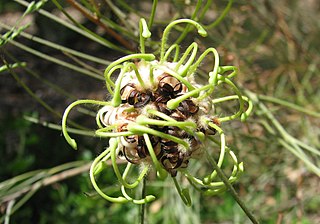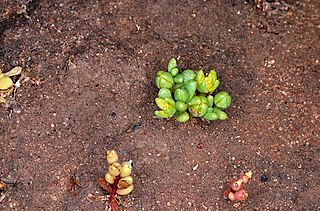
Banksia audax is a species of shrub that is endemic to Western Australia. It has fissured, grey bark, woolly stems, hairy, serrated leaves and golden orange flower spikes.

Ozothamnus is a genus of plants found in Australia, New Zealand and New Caledonia.

Banksia erythrocephala is a species of prickly shrub that is endemic to Western Australia. It has erect stems, sharply pointed pinnatifid leaves, cream-coloured and reddish black or all cream-coloured and yellow flowers, and egg-shaped fruit.
Banksia foliosissima is a species of erect shrub that is endemic to Western Australia. It has densely crowded, pinnatifid leaves, golden yellow flowers in heads of up to one hundred, and egg-shaped follicles. It is only known from two small areas in the south-west of the state.

Euryomyrtus is a genus of shrubs, in the family Myrtaceae, all of which are endemic to Australia.
Grevillea candicans is a shrub which is endemic to the south-west of Western Australia. It usually grows to between 1 and 5 metres in height and produces white or cream flowers between August and October in its native range.
Grevillea acacioides, is a shrub which is endemic to Western Australia.

Grevillea globosa is a shrub in the family Proteaceae. It is endemic to Western Australia, occurring in the northern wheatbelt.

Lambertia orbifolia, commonly known as the roundleaf honeysuckle, is a shrub or small tree that is endemic to the south-west of Western Australia. It has more or less circular leaves and groups of between four and six orange-red flowers.

Persoonia stricta is a species of flowering plant in the family Proteaceae and is endemic to the south-west of Western Australia. It is an erect, spreading shrub with smooth bark, linear to spatula-shaped or oblong leaves, and bright yellow flowers borne in groups of four to twenty-five on a rachis 3–100 mm (0.12–3.94 in) long, each flower with a leaf or scale leaf at its base.
Grevillea berryana is a small tree or shrub of the genus Grevillea native to Pilbara, Mid West and Goldfields regions of Western Australia.
Grevillea yorkrakinensis is a shrub of the genus Grevillea native to Western Australia.

Gunniopsis is a genus of flowering plants in the iceplant family, Aizoaceae. These plants are found in areas of inland Australia.

Gunniopsis intermedia, commonly known as yellow salt star, is a succulent plant in the iceplant family, Aizoaceae. It is endemic to Australia.
Gunniopsis quadrifida, the Sturts pigface, is a plant endemic to Australia that is within the family Aizoaceae. This family consists of a diverse array of species that inhabit arid and/or saline coastal and inland areas, with the plants displaying leaf morphology that is conducive to such harsh environments. Typical features of members of this genus that lie within this family of succulents includes the presence of fleshy-leaves that acts as a water reservoir for the plant with the habit of a smalls shrub.
Gunniopsis divisa is a succulent plant in the iceplant family, Aizoaceae. It is endemic to Western Australia.
Gunniopsis propinqua is a succulent plant in the iceplant family, Aizoaceae. It is endemic to Western Australia.
Gunniopsis rubra is a succulent plant in the iceplant family, Aizoaceae. It is endemic to Western Australia.

Gunniopsis septifraga, commonly known as green pigface, is a species of flowering plant in the iceplant family, Aizoaceae and is endemic to Australia. It is a prostrate to tuft-forming annual herb, with oblong to lance-shaped leaves and small greenish flowers, that grows around salt lakes.
Gunniopsis glabra is a succulent plant in the iceplant family, Aizoaceae. It is endemic to Western Australia.








